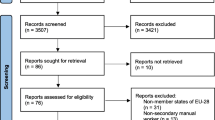Abstract
Objectives: To describe the course of employee-individual clinical status with respect to upper limb musculoskeletal disorders (UL-MSDs), epidemiological surveillance of UL-MSDs was implemented for three consecutive years at a household appliance assembly company. Methods: A standardized clinical examination guide was used to survey UL-MSDs of employees seen in annual consultation. Recorded data included eight specific UL-MSDs as well as the main sociodemographic characteristics of employees. Univariate and multivariate analysis were performed. Significance was defined as P<0.05. All statistical analysis were performed with Statgraphics (version 5.1) software. Results: During three consecutive years, 459 employees were seen in the occupational medicine consultation. The annual prevalence of UL-MSD cases was 20.2% in 2000, 21.7% in 2001 and 24.0% in 2002. In fact, this relative stability conceals significant renewal of the population suffering from UL-MSDs with time, illustrated by both a high rate of annual incidence of cases (9.8 and 13.5% in 2001 and 2002, respectively) and a high rate of annual recoveries (37.0 and 44.3% in 2001 and 2002, respectively). Conclusion: Factors governing variation in individual clinical status of employees with respect to UL-MSDs and their interactions remain little known and open up interesting research prospects.



Similar content being viewed by others
References
Aptel M, Gerling A (2000) Démarche de prévention des TMS et outils. Documents pour le médecin du travail 6:14–31
Bonde JP, Mikkelsen S, Andersen JH et al (2003) Prognosis of shoulder tendonitis in repetitive work a follow up study in a cohort of Danish industrial and service workers. Occup Environ Med 60:e8
Carrivick JW, Lee AH, Yau KKW (2002) Effectiveness of a work risk assessment team in reducing the rate, cost and duration of occupational injury. J Occup Environ Med 44(2):155–159
Cole DC, Manno M, Beaton D, Swift M (2002) Transitions in self reported musculoskeletal pain and interference with activities among newspaper workers. J Occup Rehabil 12(3):163–174
Dahlberg R, Karlqvist L, Bildt C, Nykvist K (2004) Do work technique and musculoskeletal symptoms differ between men and women performing the same type of work tasks? Appl Ergon 35:521–529
Déontologie et bonnes pratiques en épidémiologie (1998) Recommandations de l’Association Des Epidémiologistes de Langue Française (ADELF)
Jonsson BG, Persson J, Kilbom A (1988) Disorders of the cervico-brachial region among female workers in the electronics industry—a two-year follow up. Int J Ind Ergon 3:1–12
Kaergaard A, Andersen JH (2000) Musculoskeletal disorders of the neck and shoulders in female sewing machine operators prevalence, incidence and prognosis. Occup Environ Med 57:528–534
Meyer JP, Sluiter JK, Rest KM, Frings-Dresen M, Delaruelle D, Privet L, Roquelaure Y (2002) Troubles musculosquelettiques du membre supérieur liés au travail—Consensus clinique pour le repérage des formes précoces de TMS. Arch Mal Prof 63(1):32–45
Morse TF, Dillon C, Warren N, Levenstein C, Warren A (1998) The economic and social consequences of work-related musculoskeletal disorders the Connecticut Upper-Extremity Surveillance Project (CUSP). Int J Occup Environ Health 4(4):209–216
Roquelaure Y, Mariel J, Fanello S et al (2002) Active epidemiological surveillance of musculoskeletal disorders in a shoe factory. Occup Environ Med 59:452–458
Sluiter JK, Rest KM, Frings-Dresen M (2001) Criteria document for evaluation of the work-relatedness of upper extremity musculoskeletal disorders. Scand J Work Environ Health 27(Suppl 1):1–102
Takala EP, Viikari-Juntura E, Moneta GB, Saarenmaa K, Kaivanto K (1992) Seasonal variation in neck and shoulder symptoms. Scand J Work Environ Health 18:257–261
de Zwaart BCH, Frings-Dresen M, van Dijk FJH (1995) Physical workload and the ageing worker: a review of the literature. Int Arch Occup Environ Health 68:1–12
de Zwaart BCH, Frings-Dresen MHW, Kilbom A (2001) Gender differences in upper extremity musculoskeletal complaints in the working population. Int Arch Occup Environ Health 74:21–30
Acknowledgements
This study was supported by the French National Research and Safety Institute for the prevention of occupational accidents and diseases (INRS).
Author information
Authors and Affiliations
Corresponding author
Rights and permissions
About this article
Cite this article
Aublet-Cuvelier, A., Aptel, M. & Weber, H. The dynamic course of musculoskeletal disorders in an assembly line factory. Int Arch Occup Environ Health 79, 578–584 (2006). https://doi.org/10.1007/s00420-006-0092-9
Received:
Accepted:
Published:
Issue Date:
DOI: https://doi.org/10.1007/s00420-006-0092-9




